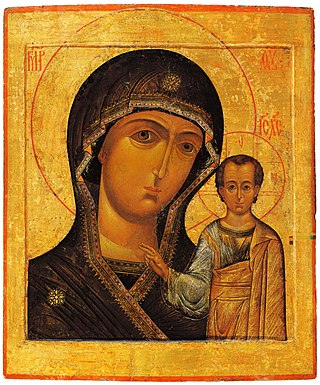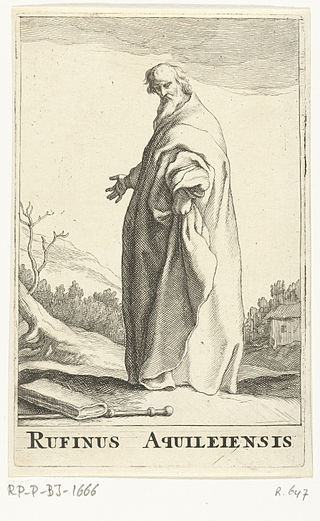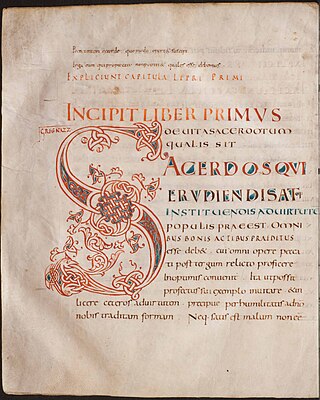Related Research Articles
Eusebius of Alexandria is a 6th-century Christian author to whom certain extant homilies are attributed.

Pseudo-Dionysius the Areopagite was a Greek author, Christian theologian and Neoplatonic philosopher of the late 5th to early 6th century, who wrote a set of works known as the Corpus Areopagiticum or Corpus Dionysiacum.

Theotokos is a title of Mary, mother of Jesus, used especially in Eastern Christianity. The usual Latin translations are Dei Genitrix or Deipara. Familiar English translations are "Mother of God" or "God-bearer" – but these both have different literal equivalents in Greek, Μήτηρ Θεοῦ and Θεοφόρος.

Theodoret of Cyrus or Cyrrhus was an influential theologian of the School of Antioch, biblical commentator, and Christian bishop of Cyrrhus (423–457). He played a pivotal role in several 5th-century Byzantine Church controversies that led to various ecumenical acts and schisms. He wrote against Cyril of Alexandria's 12 Anathemas which were sent to Nestorius and did not personally condemn Nestorius until the Council of Chalcedon. His writings against Cyril were included in the Three Chapters Controversy and were condemned at the Second Council of Constantinople. Some Chalcedonian and East Syriac Christians regard him as blessed.

John of Damascus or John Damascene was an Arab Christian monk, priest, hymnographer, and apologist. Born and raised in Damascus c. 675 or 676; the precise date and place of his death is not known, though tradition places it at his monastery, Mar Saba, near Jerusalem on 4 December 749.

Hippolytus of Rome was a Bishop of Rome and one of the most important second-third century Christian theologians, whose provenance, identity and corpus remain elusive to scholars and historians. Suggested communities include Rome, Palestine, Egypt, Anatolia and other regions of the Middle East. The best historians of literature in the ancient church, including Eusebius of Caesarea and Jerome, openly confess they cannot name where Hippolytus the biblical commentator and theologian served in leadership. They had read his works but did not possess evidence of his community. Photios I of Constantinople describes him in his Bibliotheca as a disciple of Irenaeus, who was said to be a disciple of Polycarp, and from the context of this passage it is supposed that he suggested that Hippolytus so styled himself. This assertion is doubtful. One older theory asserts he came into conflict with the popes of his time and seems to have headed a schismatic group as a rival to the bishop of Rome, thus becoming an antipope. In this view, he opposed the Roman Popes who softened the penitential system to accommodate the large number of new pagan converts. However, he was reconciled to the Church before he died as a martyr.

Maximus the Confessor, also spelled Maximos, otherwise known as Maximus the Theologian and Maximus of Constantinople, was a Christian monk, theologian, and scholar.

Prosper of Aquitaine, also called Prosper Tiro, was a Christian writer and disciple of Augustine of Hippo, and the first continuator of Jerome's Universal Chronicle.

Tyrannius Rufinus, also called Rufinus of Aquileia, was a monk, philosopher, historian, and theologian who worked to translate Greek patristic material, especially the work of Origen, into Latin.

Dumitru Stăniloae was a Romanian Orthodox Christian priest, theologian and professor. He worked for over 45 years on a comprehensive Romanian translation of the Greek Philokalia, a collection of writings on prayer by the Church Fathers, together with the hieromonk, Arsenie Boca, who brought manuscripts from Mount Athos. His book, The Dogmatic Orthodox Theology (1978), made him one of the best-known Christian theologians of the second half of the 20th century. He also produced commentaries on earlier Christian thinkers, such as St Gregory of Nyssa, Saint Maximus the Confessor, and St Athanasius of Alexandria. He is also remembered as editor in chief of the regional orthodox newspaper Telegraful Român (1934–1945) where he imposed a nationalist and antisemitic editorial line.

Sophia is a central idea in Hellenistic philosophy and religion, Platonism, Gnosticism and Christian theology. Originally carrying a meaning of "cleverness, skill", the later meaning of the term, close to the meaning of phronesis, was significantly shaped by the term philosophía as used by Plato.

Patristics or patrology is the study of the early Christian writers who are designated Church Fathers. The names derive from the combined forms of Latin pater and Greek πᾰτήρ (father). The period of the Church Fathers, commonly called the Patristic era, is generally considered to run from the end of New Testament times or end of the Apostolic Age to either AD 451 or to the Second Council of Nicaea in 787.
Hesychius of Jerusalem was a Christian priest and exegete, active during the first half of the fifth century. Nothing certain is known as to the dates of his birth and death (450s?), or, indeed concerning the events of his life. Bearing as he does the title πρεσβύτερος "priest", he is not to be confused with Bishop Hesychius of Jerusalem, a contemporary of Gregory the Great.

Palamism or the Palamite theology comprises the teachings of Gregory Palamas, whose writings defended the Eastern Orthodox practice of Hesychasm against the attack of Barlaam. Followers of Palamas are sometimes referred to as Palamites.
Catholic dogmatic theology can be defined as "a special branch of theology, the object of which is to present a scientific and connected view of the accepted doctrines of the Christian faith."

A catena is a form of biblical commentary, verse by verse, made up entirely of excerpts from earlier Biblical commentators, each introduced with the name of the author, and with such minor adjustments of words to allow the whole to form a continuous commentary.
Liber Scintillarum is a late seventh or early eighth-century florilegium of biblical and patristic sayings in Latin. It was compiled by Defensor, a monk who in the preface identifies himself as a member of St Martin's Abbey at Ligugé, near Poitiers, and who wrote the work at the behest of his teacher Ursinus, the abbot of St Martin's. Virtually nothing is known of the monk beyond what the preface offers us. The compilation was written sometime between 636, when the important source Isidore of Seville died, and about 750, when the earliest extant manuscript appears to have been produced.

The Collectio canonum quadripartita is an early medieval canon law collection, written around the year 850 in the ecclesiastical province of Reims. It consists of four books. The Quadripartita is an episcopal manual of canon and penitential law. It was a popular source for knowledge of penitential and canon law in France, England and Italy in the ninth and tenth centuries, notably influencing Regino's enormously important Libri duo de synodalibus causis. Even well into the thirteenth century the Quadripartita was being copied by scribes and quoted by canonists who were compiling their own collections of canon law.

The Church Fathers, Early Church Fathers, Christian Fathers, or Fathers of the Church were ancient and influential Christian theologians and writers who established the intellectual and doctrinal foundations of Christianity. The historical period in which they worked became known as the Patristic Era and spans approximately from the late 1st to mid-8th centuries, flourishing in particular during the 4th and 5th centuries, when Christianity was in the process of establishing itself as the state church of the Roman Empire.

The Sacra Parallela is a Byzantine florilegium of quotes in Greek from the Bible and patristic texts used in the instruction of ethics, morals and asceticism.
References
- ↑
 Herbermann, Charles, ed. (1913). "Florilegia". Catholic Encyclopedia . New York: Robert Appleton Company.
Herbermann, Charles, ed. (1913). "Florilegia". Catholic Encyclopedia . New York: Robert Appleton Company. - ↑ First completely edited from a manuscript in the Vatican Library by Franz Diekamp, Doctrina Patrum de incarnatione verbi. Ein griechisches Florilegium aus der Wende des 7. und 8. Jahrhunderts, Münster, 1907.
- ↑ D. Chenguélia, Les Témoignages Choisis dans le Dogmatikon d` Arsen d` Iqaltho – une traduction géorgienne de la Doctrina Patrum, Le Muséon, 124 (1-2), 2011, p. 59-75; D. Shengelia, The author of the scholia of the Doctrina Patrum, in: Georgian Christian Thought and Its Cultural Context, Memorial Volume for the 125th Anniversary of Shalva Nutsubidze (1888-1969), ed. T. Nutsubidze, C. Horn and B. Lourié, Leiden, Brill,2014, 128-137.
- ↑ Diekamp ascribes the work to the period between the years 685 and 726, and though nothing can be said with certainty concerning the author, a slight probability points to Anastasius of Sinai as its compiler.
- ↑ Migne, Patrologia Graeca , CLIII, 1089-92.
- ↑ "Fragmenta Vornicänischer Kirchenväter aus den Sacra Parallela", Leipzig, 1899.
- ↑ Migne, P. G., CXXXVI, 765-1124.
- ↑ P. G., XCV, 1040-1586; XCVI, 9-544.
![]() This article incorporates text from a publication now in the public domain : Herbermann, Charles, ed. (1913). "Florilegia". Catholic Encyclopedia . New York: Robert Appleton Company.
This article incorporates text from a publication now in the public domain : Herbermann, Charles, ed. (1913). "Florilegia". Catholic Encyclopedia . New York: Robert Appleton Company.